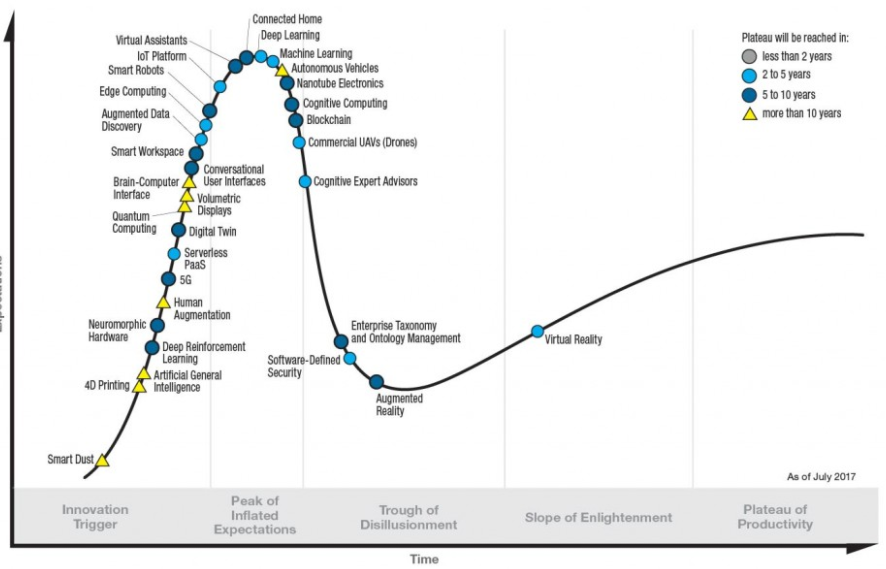
How AI Fares in Gartner’s Latest Hype Cycle

It’s late summer, which means three things: pennant races heat up in baseball, kids go back to school, and Gartner releases its annual Hype Cycle for Emerging Technologies. Much of the hype in this year’s cycle, not surprisingly, centers on artificial intelligence, or AI.
Gartner identified AI Everywhere as one of three “megatrends” for the 2017 report (the others are transparently immersive experiences and digital platforms). The hype surrounding AI and related technologies has certainly perked up in 2017, as the IT and analytics industry appears to have picked up its considerable luggage related to big data analytics and deposited it firmly on the AI train.
With AI now broadly carrying the torch for big data analytics, it’s no surprise that we’re seeing continued excitement around related technologies, particularly machine learning and deep learning.
“AI technologies will be the most disruptive class of technologies over the next 10 years due to radical computational power, near-endless amounts of data and unprecedented advances in deep neural networks,” says Mike J. Walker, research director for Gartner. “These will enable organizations with AI technologies to harness data in order to adapt to new situations and solve problems that no one has ever encountered previously.”
Gartner has added several technologies related to AI to the Hype Cycle this year, including deep learning, deep reinforcement learning, edge computing, cognitive computing, and artificial general intelligence.
Deep learning debuted at the peak of the hype curve, indicating grossly inflated expectations. Nevertheless, Gartner predicts deep learning will pay off in a two-to-five year timespan, at which point they will enter the Plateau of Productivity.
Right next to deep learning at the top the hype curve is deep learning’s first cousin, machine learning, which basically remains in the same spot as it was in 2016. Gartner calls machine learning “one of the hottest concepts in technology” that “has the potential to benefit industries from supply chain to drug research.”
Machine learning is becoming ubiquitous, and Gartner predicts it will enter the plateau within two to five years (in fact, machine learn ing is already widely used across industries). “It will soon become impossible,” Gartner says, “for conventional engineering solutions to handle the increasing amounts of available data. Machine learning offers the ability to extract certain knowledge and patterns from a series of observations.”
Another related technology, deep reinforcement learning – which is a form of supervised learning involving neural networks — has just emerged from its Innovation Trigger. Gartner says deep reinforcement learning has at least five to 10 years before it reaches the plateau.
Gartner is not the only one to see these three terms – machine learning, deep learning, and artificial intelligence – coalescing in a way to represent a broad swath of the cutting-edge analytical functions that organizations are trying to perform on their data sets today. As you can see from the Google Trends report, interest in those three terms is growing in a similar manner.
Several technologies fell off Gartner’s Hype Cycle, which either indicates they’re no longer emerging, which happened to the phrase “big data” two years ago, or that their hype levels have died down (as humans, we only have so much cognitive bandwidth to devote to hype).
Falling off this year’s cycle include Natural-Language Question Answering, Personal Analytics, and Smart Data Discovery. Augmented Data Discovery, which is climbing the curve and has a payoff of two to five years, has largely taken the place of Smart Data Discovery.
Other technologies added to the Hype Cycle this year include 5G, digital twin, and serverless PaaS. Other technologies falling off the list include 802.11ax, affective computing, context brokering, gesture control devices, data broker PaaS (dbrPaaS), micro data centers, and virtual personal assistants.
Smart Dust Update: We’ve seen smart dust on the Gartner Hype Cycle for years. But the technology –which refers to a system of tiny sensors, robots or other devices that can detect light, temperature, vibration, magnetism, or chemicals — has failed to make any headway from its initial Innovation Trigger, and is still more than 10 years away from reaching the Plateau of Productivity.
Related Items:
Why Gartner Dropped Big Data Off the Hype Curve
Smart Machines’ Top the Hype Cycle, Gartner Says































